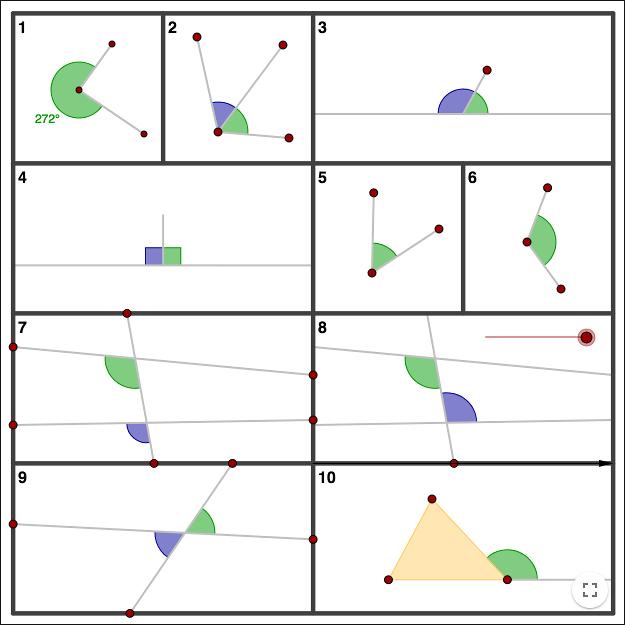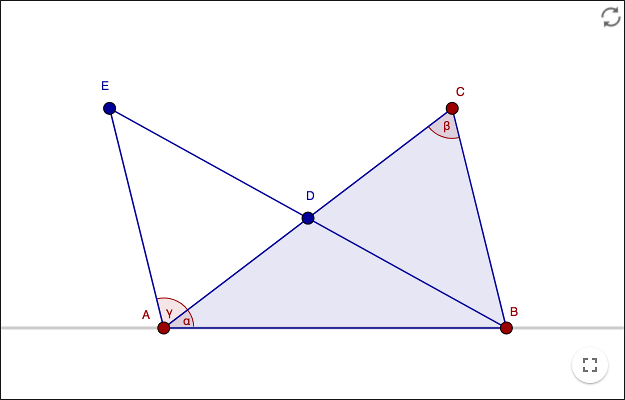Summary - Angles
Definitions
Change the slider to see variants of corresponding angles and alternate angles.
- The angle of one revolution is 360°.
- Two angles sharing a common ray are called adjacent.
- Two adjacent angles lying along a line are called supplementary angles.
- If two supplementary angles are equal they are right angles.
- An angle that is smaller than one right angle is an acute angle.
- An angle that is larger than one right angle and smaller than two right angles is an obtuse angle.
- A line intersecting two other lines is called a transversal. The angles are corresponding angles.
- The angles are alternate angles.
- The angles are vertical angles.
- The angle is an exterior angle to the triangle.
Note: Number 1 has been added to the list even though degrees are not mentioned in the Elements by Euclid.
GeoGebra tasks
Make a line a through the points A and B, and a line b through the points C and D. Enter the point of intersection E and the angle α. Place a point F on the line b.
Task 1
Make an angle β at the point F equal to α , and such that β becomes an alternate angle when a new line is drawn. What can you say about the line a and the new line?
Task 2
Make an angle β at the point F equal to α , and such that β becomes a corresponding angle when a new line is drawn. What can you say about the line a and the new line?
Theorems
Theorem 1 Vertical angles are equal.
Theorem 2 In any triangle, the sum of two interior angles is less than two right angles.
Theorem 3 If two lines are intersected by a transversal, and if alternate angles are equal, then the two lines are parallel.
Theorem 4 If two parallel lines are intersected by a transversal, then alternate angles are equal.
Theorem 5 If two lines are intersected by a transversal, and if corresponding angles are equal, then the two lines are parallel.
Theorem 6 If two parallel lines are intersected by a transversal, then corresponding angles are equal.
Theorem 7 - The Exterior Angle Theorem An exterior angle of a triangle is equal to the sum of the two remote interior angles.
Theorem 8 The sum of the interior angles of a triangle is two right angled.
Theorem 9 The converse of the isosceles triangle theorem If two angles in a triangle are equal, then the triangle is isosceles.
Exercises
The theorems you should know by before doing this, are: the congruence cases SAS, SSS, ASA, and the theorem about angles in an isosceles triangle.
Exercise 1
Prove Theorem 1
Exercise 2
In the demonstration below, D is the midpoint of the segment AC and also the midpoint of the segment BE. As long as the vertices of the triangle have the counterclockwise order A, B, C; the sum of α and γ is less than two right angles. Show that γ=β. Then prove Theorem 2. You are only allowed to use theorems that have already been proved.
Exercise 3
Prove Theorem 3. Try to do a proof by contradiction, i.e. assume that your proposition is not true; then show that this assumption leads to a contradiction. Then use Theorem 3 to prove Theorem 4, a proof by contradiction works in this case as well.
Exercise 4
Use some of the theorems proved so far to prove Theorem 5 and 6.
Exercise 5
Prove Theorem 7 - The Exterior Angle Theorem. Use the picture below. The line l is parallel to AC.
Exercise 6
Prove Theorem 8.
Exercise 7
Prove Theorem 9! Hint: draw an angle bisectris at one of the vertices of the triangle.
by Malin Christersson under a Creative Commons Attribution-Noncommercial-Share Alike 2.5 Sweden License

